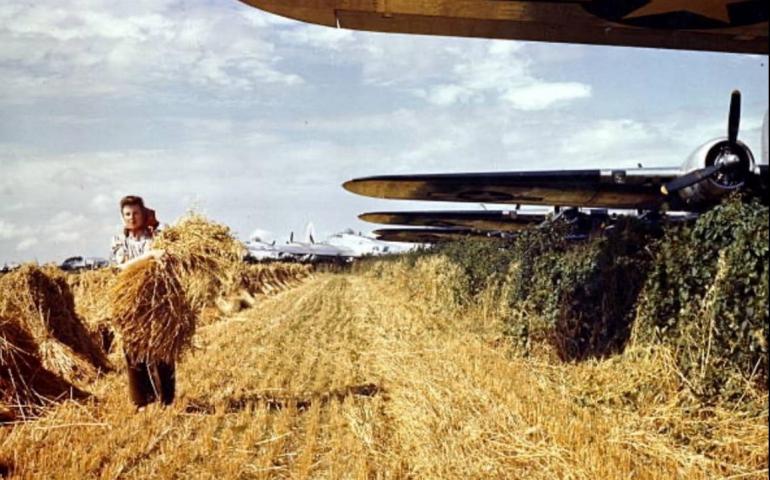
It is to the US - Army Airforce what Normandy is to the U.S. Army. The monuments are harder to find, but if you’re willing to leave the main roads, you will discover a countryside still eloquent of one of the greatest military efforts in history. From 1941 to 1945 the biggest aircraft carrier in the North Atlantic was England. Once the U.S. 8th Air Force arrived in 1942, a new field was started every three days. By war’s end there were more than 700 airfields spread across the country; the 8th had built 130 of them. Enough concrete had been slathered across cornfields and cow pastures to pave four thousand miles of highway—all in an area about the size of Vermont. “There were so many airfields,” one pilot, Ray Galceran, recalls, “you could cut your engines at ten thousand feet and take your choice. Land anywhere.” Most of the bases were concentrated in the rural countryside of East Anglia, that broad peninsula of Suffolk, Norfolk, Essex, and Cambridgeshire that presses into the North Sea like a thumb. Today this bucolic land, still green with the memories of the men who served on it, is to the U.S. Air Force what Normandy, Midway, and Iwo Jima are to the lore of the Army, Navy, and Marines. This may be why an East Anglian from Lavenham or Bury St. Edmunds might first draw a deep breath before he talks about the men of the 8th, and speak with emotion when he does. Every one of these American fliers is honored as a hero, even if he never did another decent thing in his life. It was enough that these men once went to Germany in the frigid bellies of B-17s and that some came back and some didn’t. Today the bucolic land is still green with the memories of the 8th Air Force men who served there. “I was five or six years old in 1944,” says Ian Hawkins, who lives near Framlingham and has written a couple of books about those days. “We were used to the sound of American bombers. Paid no more mind to them than we did to the sound of a tractor engine. But I remember one day hearing an unearthly roar so loud I could feel floorboards jump under my feet. I ran outside and looked up. I’d never seen anything like it. More than a thousand B-17s were rendezvousing in a black cloud that just kept coming and coming. Imagine! Four thousand engines, five million horsepower. It’s something the world will never see again.” No American or East Anglian can think seriously about B-17s today without feeling the tug of their great purpose and destiny. They were the two-fisted tin cans that tore the roof off a deranged empire. When they swarmed over occupied Europe, people blessed them. One day several hundred roared across Holland, according to Rex Alan Smith in his book One Last Look, and a little girl cried in fear. Her father put his arm around her, took her hand, and looked up. “Listen to it, Helene,” he told her. “It’s the music of angels.” So you throw your imagination up into the silent skies of East Anglia, and sure enough, there they are — five million white horses galloping across the winds of England to the rescue of a kidnapped civilization. “We would come into these small communities in huge numbers,” says Dan O’Dell, a pilot in the 390th now living in Houston. “We were different from the English. Noisy, a little rowdy. But after they’d see our planes go out in the morning and come back at night — always more going out than coming back — they started calling us ‘our boys.’” Any American who travels to England in search of the 8th must understand this sense of pride. Otherwise the derelict old hangars, towers, and Nissen huts that spot the land will have no meaning. East Anglia is much the same open landscape today it was when Roman legions first arrived two thousand-odd years ago. Outside Ipswich, Norwich, or Cambridge there is nothing even remotely urban about this loosely populated farm country. Roads ramble over the soft rolls of the country from one little town to another. A pub is never far away, and its floorboards creak when you enter; ancient wood beams sag overhead. Little you see today suggests what once went on here. The clues are subtle and may be overlooked from the ground. The air bases are not always apparent. Signs rarely announce their presence, and usually no main road will lead you to them. But then, they weren’t intended to stand out. And now accumulations of time and neglect have further camouflaged their remains. You may spot a patch of bleached concrete, for instance, lying disembodied on the edge of a bean field. If wedges of grass and weeds push up between its slabs, if weather has eroded its veneer of bituminous binding and chipped away at its edges, if only a pocked undersurface of gravel and stones remains, you may be looking at the remains of a bomber runway.Or you may spot a neglected storage shed with some farm equipment inside. Look carefully. If it’s a Quonset hut, half swallowed up in underbrush, its corrugated metal skin rusted through, you may have come upon the remains of an 8th Air Force barracks hut or station office.
Source: John McDonough
The Eigtht in the East